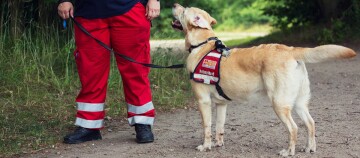What Therapy Dogs Are About and What It Means for Dogs to Help Humans
07.10.2022 - Reading time: 5 minutes

People who own a dog recognise the phenomenon: closeness to the dog relaxes stress and nerves, comforts us in sadness and relieves anxiety. This healing effect that dogs have on many people has actually been medically proven. So it is no wonder that the use of so-called therapy dogs is increasing more and more. But not every dog is capable of doing this in the same way. Find out here what therapy dogs are really all about.
Therapy dog – what does that mean?
Therapy dogs are professionally trained dogs that work in medical settings. They help people to surmount certain illnesses or to alleviate the symptoms of other illnesses. Therapy dogs are used specifically as part of medical treatments and have so far proven themselves in particular in areas like speech therapy, remedial education, occupational therapy and psychotherapy. They alleviate anxiety, outbursts of aggression, speech or social disorders and a range of stress symptoms.
Therapy dogs are used in an area called “animal-assisted therapy”, which is a new field of medical therapy. Therefore, the use (and training) of therapy dogs is subject to constant development. Basically, the therapy dog fulfils a certain task within a therapeutic session, one which is individually determined in advance.
Distinctions between therapy dog, assistance dog and guide dog
- A therapy dog is distinguished from so-called assistance or service dogs, which are permanent companions for people with intellectual or physical disabilities.
- A further distinction is made to so-called visiting dogs. These are accompanied by attendants and are mainly used in old people’s homes or children’s homes. Here they are supposed to help the people concerned interact socially.
Becoming a therapy dog - can every dog do it?
In principle, all domestic dogs can become therapy dogs, regardless of breed, size or gender. However, they must fulfil some basic requirements. First and foremost, they must have a gentle, patient character that is not easily unsettled. Future therapy dogs should approach people with no suspicion or aggression and distinguish themselves by their balanced, self-confident but not dominant or pushy nature.
- When training to become a therapy dog, suitable candidates and their handlers have to pass a companion dog test. Here, the dog-human team must prove that they are in excellent harmony with each other. Special tests complete the training of handler and therapy dog.
- Dogs that show great affection for people are particularly suitable for a career as a therapy dog. There are breeds that are more predestined for this than others. Certain hunting dog breeds, companion dogs and social dogs are among these.
- Dog breeds such as the Hungarian Vizsla, Labrador, Golden Retriever and Poodle have proven themselves. Gentle giants such as the Bernese Mountain Dog, St. Bernard, Leonberger and Newfoundland are also stalwarts, but it doesn’t always have to be a pedigree dog, because mixed breeds often also have very good potential to be a therapy dog.
- The area of therapeutic use often determines whether the therapy dog should be big or small. For children, adolescents and intellectually disabled adults, sturdy, robust dogs are more suitable. On the other hand, smaller therapy dogs are the better choice for old and frail patients.
Early training: early selection to become a therapy dog
Professional therapy dogs are often selected as puppies and trained at an early age. Special puppy tests and regular observation of the young dogs’ development are used to assess the young therapy dog candidates. As the demand for therapy dogs is steadily increasing, targeted breeding with a specific focus on suitable traits is also on the rise. The puppies from these associations grow up in a pack of trained therapy dogs from the very beginning and already pick up the right characteristics from their dog parents at their most tender age.
What does a therapy dog do?
Dogs seem to develop a “sixth sense” for when we humans are physically or emotionally unwell. They sense their humans’ moods and actively try to comfort them. Scientific tests have proven that the therapeutic use of dogs helps to lower high blood pressure and reduce stress.
Dogs are able to create a a relaxed, comforting and, in the truest sense of the word, healing atmosphere by their presence and attention alone. Their job is to convey a sense of compassion, security and safety to patients. This happens directly and unconditionally and works with many neurological, psychological or social problems in a fascinating way.
Additional therapeutic steps can in turn build on this, and even medicines may be absorbed better by the body. This is partly explained by the hormone oxytocin, also known as the “cuddle hormone”, which is released when people stroke dogs. The therapy dog is used exclusively as part of a team together with a professional doctor, therapist or educator. His handler is always at his side. Therapy dogs cannot replace medical treatment.
Rules for the welfare of the therapy dogs and their patients
A therapy dog’s work is exhausting and stressful, especially when it is used with children with intellectual/physical disabilities, in groups or in unfamiliar environments with strong smells.
- This means that a therapy dog’s working hours are regulated by law and are usually limited to a maximum of 45 minutes per day. In exceptional cases, when several animals are used simultaneously in a therapy session, the dog’s working time may be increased to two hours. Individual therapy sessions may only be accompanied by a therapy dog three times a week. This is the only way to guarantee that the therapy dog can properly perform its task without actually needing therapy itself.
- For this reason, therapy dogs are not allowed to be kept in an institution, they have to live with the dog’s owner.
- Of course, every dog being used in the field needs to be absolutely healthy and mentally well-balanced.
- Regular worming and vet visits are mandatory for therapy dogs.
- At the same time, care must be taken to ensure that the dog does not carry infections. This does not mean potential canine pathogens, but what are called “infectious nosocomial agents” that can particularly occur in hospitals.


